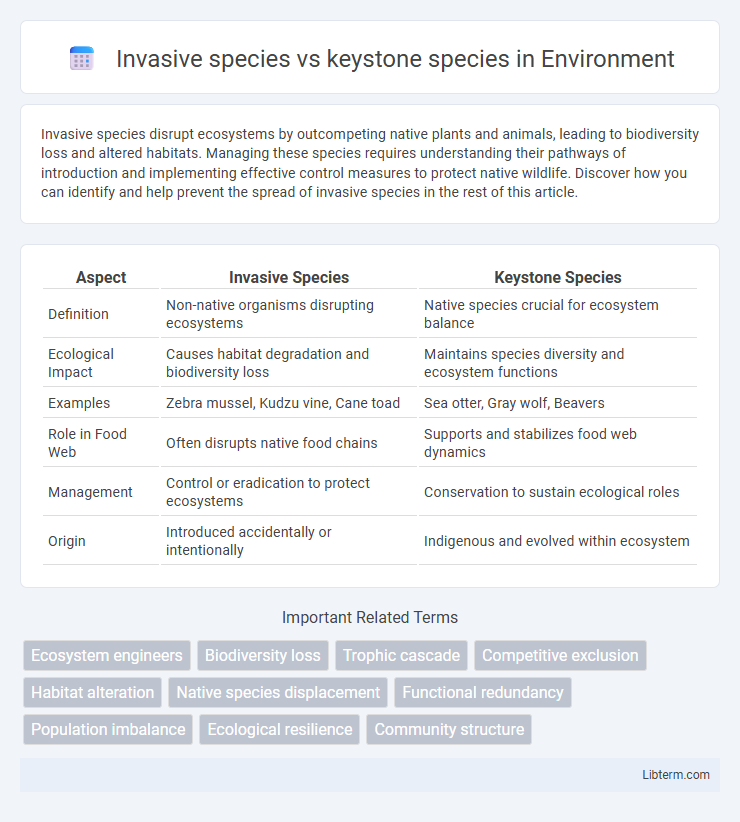Invasive species disrupt ecosystems by outcompeting native plants and animals, leading to biodiversity loss and altered habitats. Managing these species requires understanding their pathways of introduction and implementing effective control measures to protect native wildlife. Discover how you can identify and help prevent the spread of invasive species in the rest of this article.
Table of Comparison
| Aspect | Invasive Species | Keystone Species |
|---|---|---|
| Definition | Non-native organisms disrupting ecosystems | Native species crucial for ecosystem balance |
| Ecological Impact | Causes habitat degradation and biodiversity loss | Maintains species diversity and ecosystem functions |
| Examples | Zebra mussel, Kudzu vine, Cane toad | Sea otter, Gray wolf, Beavers |
| Role in Food Web | Often disrupts native food chains | Supports and stabilizes food web dynamics |
| Management | Control or eradication to protect ecosystems | Conservation to sustain ecological roles |
| Origin | Introduced accidentally or intentionally | Indigenous and evolved within ecosystem |
Introduction to Invasive and Keystone Species
Invasive species are non-native organisms that disrupt ecosystems by outcompeting native species and altering habitats, often causing significant ecological and economic damage. Keystone species play a critical role in maintaining the structure and health of their ecosystems by regulating populations and facilitating biodiversity. Understanding the contrasting impacts of invasive species and keystone species is essential for effective conservation and ecosystem management strategies.
Defining Invasive Species
Invasive species are non-native organisms that spread rapidly in a new environment, often causing harm to native ecosystems, economies, or human health. They disrupt ecological balance by outcompeting native species for resources, altering habitats, and introducing diseases. Unlike keystone species, which maintain ecosystem stability, invasive species typically reduce biodiversity and ecosystem resilience.
Understanding Keystone Species
Keystone species play a critical role in maintaining the structure and health of an ecosystem by regulating populations of other organisms and fostering biodiversity. Unlike invasive species, which disrupt native habitats and outcompete local species, keystone species promote ecological balance and stability through their interactions. Understanding keystone species is essential for conservation efforts aimed at protecting ecosystem integrity and function.
Key Characteristics: Invasive vs. Keystone
Invasive species disrupt ecosystems by rapidly spreading and outcompeting native species, often causing significant ecological damage and loss of biodiversity. Keystone species maintain ecosystem stability by playing critical roles, such as regulating populations and supporting habitat structure, despite their often low abundance. The key difference lies in invasive species destabilizing environments, while keystone species enhance ecosystem functionality and resilience.
Ecological Impacts of Invasive Species
Invasive species disrupt native ecosystems by outcompeting keystone species, leading to altered food webs and diminished biodiversity. These organisms often introduce diseases, prey on native species, and modify habitats, causing cascading ecological effects. The loss or decline of keystone species due to invasive pressures significantly impairs ecosystem stability and function.
Ecological Roles of Keystone Species
Keystone species play a critical ecological role by maintaining the structure and stability of their ecosystems, often regulating population dynamics and promoting biodiversity. Unlike invasive species that disrupt native communities and degrade habitats, keystone species contribute to ecosystem resilience by enabling various species interactions and resource availability. Their presence ensures ecological balance, supporting processes such as predation, pollination, and nutrient cycling essential for ecosystem health.
Case Studies: Invasive Species Disruptions
Invasive species like the zebra mussel in the Great Lakes drastically disrupt native ecosystems by outcompeting keystone species such as the freshwater mussel, leading to altered nutrient cycles and habitat loss. Case studies show that the introduction of the brown tree snake to Guam caused the decline of native bird populations, which functioned as keystone seed dispersers, ultimately destabilizing forest regeneration processes. These disruptions highlight how invasive species can dismantle ecological balance by displacing keystone species crucial for maintaining biodiversity and ecosystem functionality.
Case Studies: Keystone Species Importance
The sea otter population in the Pacific Northwest serves as a pivotal keystone species maintaining kelp forest ecosystems by controlling sea urchin populations, which prevents overgrazing and biodiversity loss. In contrast, invasive species like the lionfish in the Atlantic disrupt marine food webs by outcompeting native predators and decimating reef fish populations. Case studies demonstrate the critical role keystone species play in ecosystem stability, highlighting the ecological imbalance caused when invasive species dominate.
Management and Conservation Strategies
Management of invasive species prioritizes early detection, rapid response, and eradication methods to prevent ecosystem disruption, employing mechanical removal, chemical treatments, and biological control agents. Conservation strategies for keystone species emphasize habitat preservation, population monitoring, and restoration efforts to maintain their critical role in ecosystem stability and biodiversity. Integrating these approaches involves adaptive management frameworks that address invasive species threats while supporting keystone species recovery and ecosystem resilience.
Conclusion: Balancing Ecosystem Health
Invasive species disrupt native biodiversity and ecological balance by outcompeting keystone species that maintain ecosystem stability. Effective management strategies prioritize protecting keystone species to preserve food webs and habitat structure. Balancing ecosystem health requires controlling invasive populations while supporting keystone species' critical roles in ecosystem resilience.
Invasive species Infographic

 libterm.com
libterm.com